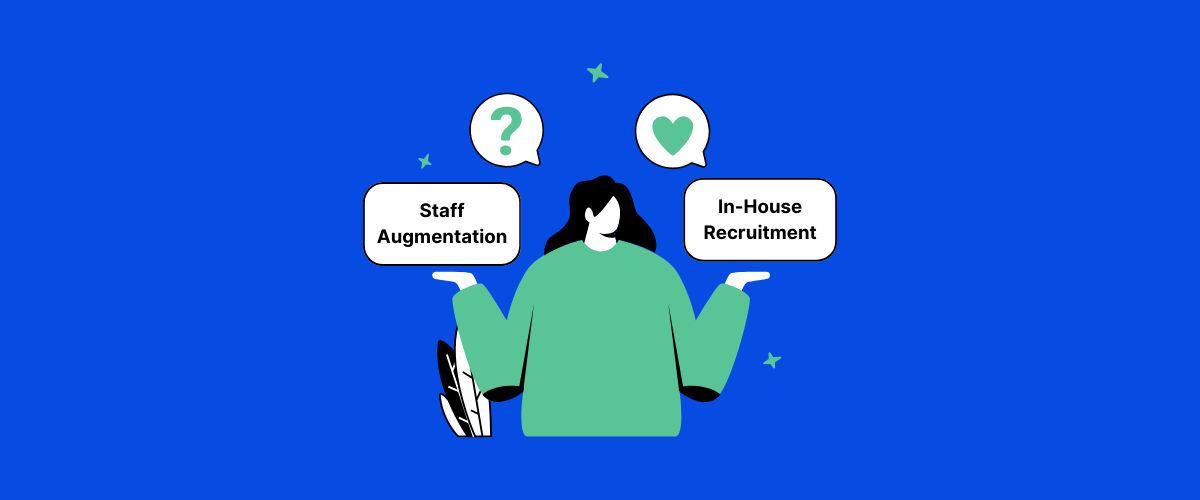According to the U.S. Bureau of Labor Statistics, the number of job openings in the information industry remains high, with 207,000 jobs reported in February 2022, up from 111,000 for the same month last year. As a result, the demand for developers in 2022 was expected to increase, and employers must find an effective way to hire.
Company owners should realize that it is the employees who ultimately make change happen. In the pursuit of top talent, there are different hiring models to consider. This article will compare two of them: in-house hiring and staff augmentation.
Table of Contents
When should businesses direct hire
In-house refers to an activity or operation conducted within a company instead of relying on outside providers. Tech companies use this option to build their core team and culture with full-time employees. In addition, in-house staff members tend to be more motivated—they go into the details of the product because they are committed to developing the product and growing the company. Therefore, in-house hiring is the best solution at the core development stage. Here are some of the pros and cons of in-house hiring:
Pros of direct hire
- Companies have greater control over the direction and management of work by their in-house employees than they would over an outside contractor.
- Local employees can come into the office when needed, even if they work remotely. Colleagues working in one location find it easier to collaborate with team members and other departments.
- Same time zone. A dedicated team operating on the same schedule will be able to address urgent issues quickly.
- Every new project is a chance to upgrade the team’s skill set.
Cons of direct hire
- Limited talent pool. Developers with knowledge of both popular and niche technologies are in short supply, especially in small metropolitan areas.
- In-house operations can be more expensive because of additional operational and administrative costs. For example, employers are usually expected to contribute to retirement plans and pay for health insurance, bonuses, office rental, and workstations.
- The recruitment process can take much longer because of background checks and additional hiring requirements, such as verifying soft skills that fit the company culture. In-house hiring process also imposes additional costs for the human resources department that dedicates time to onboard and adapt a new employee to the team.
- Staff burnout and turnover require more attention and oversight by the HR department.
- Smaller companies might not have enough work to justify hiring full-time in-house staff.
When should businesses use the staff augmentation model
Staff augmentation is a quick extension of your in-house development team. This model uses full-time employed software engineers from outsourcing agencies. However, unlike assigning or handing over an entire project to an IT outsourcing company, employers manage programmers and communicate with them directly. Let’s take a look at the pros and cons of IT staff augmentation services:
Pros of staff augmentation model
- Extensive talent pool and rapid scalability. The staff augmentation model means hiring, for example, Python developers available worldwide to work remotely. You can have a developer with the required skill set within one week.
- Compared to other project outsourcing models, contractors work directly with the in-house team, and the company has full control of the development process.
- Staff augmentation includes legal services and customer support. In particular, YouTeam prepares the contracts, and our support team assists the client throughout the contract period. We charge our customers 10% for all services.
- No additional expenses. Employers don’t need to make retirement contributions or pay for health insurance, bonuses, vacations, office rental, or workstations. Even if a contractor’s hourly rates are higher, employers find it’s still less expensive because of the lack of operational and administrative expenses.
Cons of staff augmentation model
- Augmented staff will not work in the office and may be less connected to the company culture.
- If you need an IT team working within the same time zone, the talent pool may be limited.
Critical differences between in-house hiring and staff augmentation services
Contractors set their goals to gain experience, learn new technologies, complete a project, and share their accomplishments on their LinkedIn page. Often, they prefer to focus on a specific industry or niche markets, such as fintech or healthcare.
Companies should not expect remote developers working for agencies to bond with their brand as strongly as in-house staff. In-house employees often work closely for long periods, allowing them to build relationships through outdoor meetings, corporate sports competitions, or attending a conference.
On the other hand, employers can still engage contractors in online events, introduce them to other departments, and invite them to company office parties.
Team augmentation, however, excels in the speed of hiring and the vast pool of senior developers. If clients have urgent tasks, YouTeam can provide a verified list of candidates within 48 hours. Customers also avoid the documentation and legal hassle of full-time, official employment.
| Categories | IT Staff Augmentation | In-House Recruitment |
| Control | The client retains full control over the project | The company has complete control over hiring |
| Costs | Generally, more cost-effective | Higher costs due to recruitment expenses |
| Needs | Suitable for short-term or specialized projects | Suitable for long-term or ongoing projects |
| Flexibility | Easily scalable to adjust resource needs | Less flexible, may require restructuring the workforce |
| Risks | – Compatibility and integration challenges with augmented staff;
– Communication and coordination issues with an external team. |
– Difficulty in finding suitable candidates;
– Higher time investment in the recruitment process; – Risk of making a wrong hiring decision |
| Recruitment Process | Identification of Needs. The client identifies the specific skills and expertise required for the project or task.
Job Description and Skills Specification. The requirements are translated into a job description and skills specification. Candidate Search and Screening. The vetting service conducts candidate sourcing, screening, and shortlisting. Candidate Selection. The client evaluates and selects the desired candidate(s) from the shortlist. Onboarding. The selected candidate(s) join the client’s team and undergo an onboarding process. |
Job Description and Skills Specification. The company defines the job requirements and creates a job description.
Candidate Search and Screening. The company conducts candidate sourcing, screening resumes, and possibly pre-screening interviews. Candidate Selection. The company conducts interviews, assessments, and reference checks to evaluate candidates. Onboarding. The selected candidate(s) join the company, complete necessary paperwork, and undergo orientation or training. |
Features that are common to both in-house and staff augmentation
Despite the differences, IT-staff augmentation and in-house hiring have many things in common. Contractors and in-house engineers expect to gain new knowledge, experience with niche technologies, and the initiative to find solutions independently. In addition, these highly-skilled professionals want recognition for their roles in a project. Therefore, they are enthusiastic about projects and expect long-term cooperation.
Both hiring options demand attention from managers during the onboarding process. You will need to align the workflow, establish communication between in-house and remote teams, and schedule regular feedback sessions to ensure developers understand the project.
Staff augmentation is also as safe as in-house hiring because every developer undergoes a background check.
Here are also a table with the comparison of both similar and unique features of in-house hiring and staff augmentation:
| Common Features of In-House and Staff Augmentation | Unique Features of In-House and Staff Augmentation |
| Access to skilled workforce | In-house: Greater control over work direction and management |
| Ability to collaborate with team members and other departments | Staff Augmentation: Extensive talent pool worldwide |
| Flexibility to adapt to changing business needs | In-house: Ability to work in the office |
| Accountability for project outcomes | Staff Augmentation: No additional expenses for retirement contributions, health insurance, bonuses, vacations, office rental, or workstations |
| Integration with company culture and values | In-house: Dedicated team operating on the same schedule can address urgent issues quickly |
| Opportunities to upgrade the team’s skill set with each new project | Staff Augmentation: Legal services and customer support are included in model |
Where to find and hire in-house developers
Employers can use online boards like Glassdoor, Indeed, or AngelList to post a job. Additionally, they can search LinkedIn profiles by filtering industry and service categories.
Hiring managers may also find potential candidates by searching Facebook groups related to a particular programming language or even reaching out to the top users on Stack Overflow who have answered the most questions associated with a specific technology.
Employers can go to local meetups or look for developer conferences in their area to meet professionals.
Why YouTeam should be your next staff augmentation company
YouTeam’s pool of developers consists of engineers with diverse skills, and they can quickly assemble a team for a project. One of the mechanisms that YouTeam uses in its work with contractors is the regular evaluation of software agencies. We rank software development teams that can find available tech talent rapidly. In particular, smaller agencies assign a free developer with a specific skill set more quickly because they are less bureaucratic.
Browse 500+ Dev Teams Available for Hire
Here are some advantages of hiring developers via YouTeam:
- YouTeam has pre-interviewed middle and senior developers in our pool to ensure that they are the best fit to meet customers’ requirements.
- YouTeam automates contract signing and billing between customers and software development vendors. No commitments before this point.
- A dedicated Customer Success Manager helps you facilitate your cooperation with engineers, assists with team expansion requests, and answers any legal or financial questions.
- Staff augmentation will allow you to address skill gaps quickly with additional expertise. It takes 48 hours from contacting YouTeam to receiving a verified list of candidates.
- YouTeam has received positive reviews for its professional service, skilled developers, and user-friendly interface. Clients commend the platform’s talent pool of 50,000+ developers and transparency in the hiring process.
Epilogue
Both in-house hiring and staff augmentation attract professional developers who are enthusiastic about the projects and expect long-term cooperation. The key features of the staff augmentation are the speed of hiring and the vast pool of developers, while in-house is an effective option for building a company’s core team and culture. Here is the table with the main pros and cons of each hiring model:
|
Direct Hiring Model |
Staff Augmentation Model |
|
Pros |
|
| Greater control over work direction and management of in-house employees | Extensive talent pool and rapid scalability |
| Local employees can come into the office when needed, even if they work remotely | Contractors work directly with the in-house team, and the company has full control of the development process |
| Easier collaboration among colleagues working in one location | Legal services and customer support included in the staff augmentation model |
| A dedicated team operating on the same schedule can address urgent issues quickly | No additional expenses for retirement contributions, health insurance, bonuses, vacations, office rental, or workstations |
| Every new project is a chance to upgrade the team’s skill set | |
|
Cons |
|
| Limited talent pool | Augmented staff may be less connected to company culture |
| In-house operations can be more expensive | Limited talent pool for IT teams in the same time zone |
| The recruitment process can take longer | |
| Staff burnout and turnover require more attention and oversight | |
| Smaller companies may not have enough work to justify hiring full-time in-house staff | |
Let’s also review what are the main differences of both staff augmentation and in-house hiring models:
Goals and Focus:
- Staff augmentation. Contractors prioritize gaining experience, learning new technologies, and completing projects.
- In-house hiring. Employees focus on long-term relationships, bonding with the company’s brand.
Relationship Building:
- Staff augmentation. Contractors may not bond as strongly with the brand but can be engaged in online events and company parties.
- In-house hiring. Employees have more opportunities for relationship building through meetings, competitions, and conferences.
Speed of Hiring:
- Staff augmentation. Offers fast hiring, with platforms like YouTeam providing verified candidates within 48 hours.
- In-house hiring. Typically involves a longer recruitment process with documentation and legal formalities.
Pool of Talent:
- Staff augmentation. Provides access to a vast pool of senior developers with diverse expertise.
- In-house hiring. May have a more limited talent pool based on local availability and specific skill requirements.
Employment Model:
- Staff augmentation. Contractors work remotely and are managed by the client for the project duration.
- In-house hiring. Employees are full-time staff integrated into the company’s structure and culture.
If you have any questions or ideas or need help choosing between staff augmentation and in-house hiring, don’t hesitate to contact YouTeam.








